Butter:- A dairy product
What is Butter?
Butter is a dairy product made by churning cream to separate the butterfat from the buttermilk. Butter is a solid fat made from cream of milk or full cream milk by the process of churning over and over so that the tiny globules of butter fat stick together and easily separate out from the butter milk. Butter is usually made from sweet cream. However, it can also be made from acidulated or bacteriologically soured cream.
- Butter is by far the most preferred fat due to its rich, creamy and sublime flavour which no other product can even close to matching with butter characteristic & versatile use. It is used in several cooking application including everything from making sauce & gravy, tempering, spreading on bread & sandwiches, baking several products to finishing dishes..

Characteristic of butter:-
Butter has several distinct characteristics that contribute to its unique qualities and functionality in cooking and baking. Here are the key characteristics of butter:
- Flavor:– Butter imparts a rich creamy flavor due to its high fat content. It enhance the taste of both sweet and savory dishes.
- Texture:- Butter has a smooth creamy texture that spreads easily and melts uniformly. At room temperature butter is soft and pliable, while it solidifies when chilled.
- Fat Content:-Butter typically contains around 80-82% butterfat which contributes to its rich texture and flavor. The rest are water (15-20%) and milk solids (about 1-2%).
- Melting Point:-Butter begins to melt at around 90-95°F (32-35°C).
- Color:-Butter typically has a yellow or golden color, which comes from the presence of beta-carotene in the cream. The color can vary based on the diet of the cows and the processing method.
- Storage and Shelf Life:- Butter should be stored in the refrigerator to maintain freshness and prevent spoilage. Butter can be frozen for longer storage up to 6-9 months without significant loss of quality. Freezing helps extend its shelf life and preserves its flavor.
- Baking and Cooking Properties:-In baking butter contributes flaky texture in pastries and cookies. It coats flour particles, preventing gluten formation and creating a desirable crumb structure. Butter enhances the flavor of both sweet and savory dishes.
The untold story of butter making:-
The earliest evidence of butter making date back to around 2000 years B.C. It was probably first made accidentally as nomad people (खानाबदोश लोग) probably tied their milk in the sheepskin bags on their horses. During journey, the milk which was kept in the sheep skin bags were shaking continuously and naturally churning. So when the nomad people reached their destination, he had a creamy and delicious surprise in his bags – butter. This theory is backed up by the evidence of how was butter made in the olden days. These people used sheep,goat & yalk milk to make butter instead of Cow milk.
- Because of the colder climate, butter was more popular in northern Europe. The expansion of the northern Asian tribes by conquest and colonization brought butter to the inhabitants of southern Asia. However, butter in the southern climates could not be stored as easily as it could in the frozen northern plains. The southerners were the first to clarify butter in order to keep the fat from spoiling. In india butter was clarified to make Ghee by heating the butter. The ghee we used to offer our God since ancient times as Ghee is considered to be a symbol of purity.
- It is generally believed the word butter originates from the boutyron, Greek for “cow cheese”, Although some of the earliest records of butter consumption come from Roman and Arabian sources, Mediterranean people have always favored oil in their cooking.
The main science behind manufacturing of butter
Fresh milk or cream on a microscopic level is basically looks like tiny bubbles of fat which is suspended in milk liquid. There is a Protein membranes which is surround on each fat bubble have a tendency to keep the fat from sticking together.
- When we agitate the liquid by churning it, the protein membranes which surround each bubbles of fat gets break out from fat surface resulting all the fat bubbles stick together and easily separate from butter milk and form a sold butter.
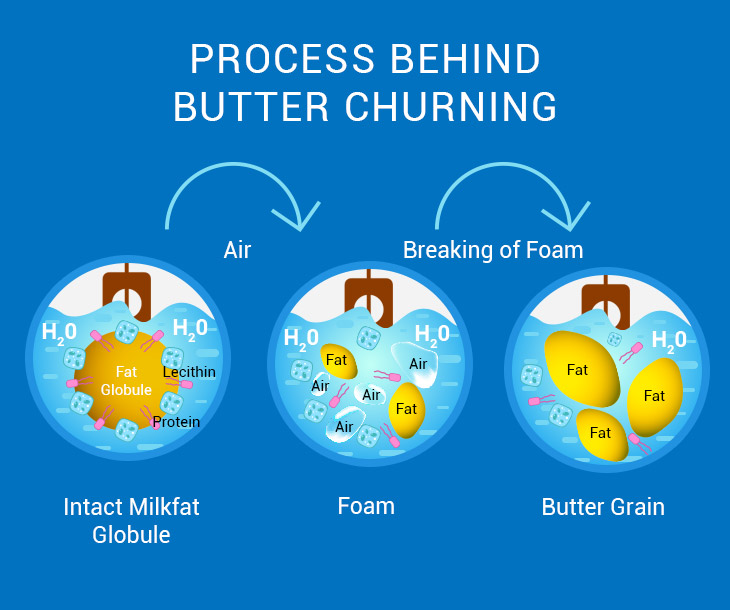
Pic source-Milkday
- The fatty solid which also contains proteins and a little water is then shaped together to form a block of butter. As we know that dairy milk consists of butter fat, milk protein & water. The color of butter can vary from pale yellow to white color.
Since milk is white in color then why butter is yellow in color. What is the reason ?
The difference in color is mainly due to the higher fat content of butter. Cows that eat grass and flowers contains yellow pigment called beta carotene which automatically store this beta carotene color pigment in the cows milk and cow does not able to converts this yellow color pigment into Vitamin A as in case of other bovine animals like goat, sheeps and water buffalo.
- The pigment gets carried over into the fat in their cow milk. Milk consists mostly of water, with just over 3 percent fat in whole milk, Cream obtain from milk usually contains about 30 to 40 percent fat whereas the butter obtain from the churning process of cream contains at least 80% of fat.
- The fat globules in cow milk or cream obtain from cow milk hiding the beta carotene pigment in their thin membrane resulting the milk looks like white color , but when we make butter by churning the cream, the thin membrane which are surrounded on fat easily breaks out and fat globules stick together and expose the beta carotene pigment resulting butter looks like yellow in color.
- however, that butter which is made from sheep’s milk, goat’s milk or water buffalo’s milk is always white in color because these animals don’t store beta carotene the way cows do. Instead, they convert it to vitamin A, which is colorless. Therefore, butter which is made of sheeps milk, goat milk & buffalo milk will not turn yellow color and remains white color.
Why salt are added in butter?
One of the demerit with Butter is that when butter is left in the open air, it will turns rancid very quickly and also butter is subject to rapid microbiological spoilage at normal temperatures. Rancid butter becomes yellow to brown and the flavor becomes harsh. Rancidity and oxidation are the main cause for degradation of butter which is very common phenomenon that is the main reason why salting is added in the butter to prevent spoilage, and to mask the taste of rancid butter.
The best way to keep butter fresh & softy spreadable: –
In order to prevent the butter turning rancid, it is advisable to keep or store fresh butter in butter crock or French butter dish where butter don’t directly interact with open air.
- The secret to keep the butter fresh and spreadable soft is to keep it in butter crock or French butter dish which is primarily made of earthenware pot/stoneware pot. The modern water-submerged butter crock is thought to have first appeared in France in the Middle Ages.
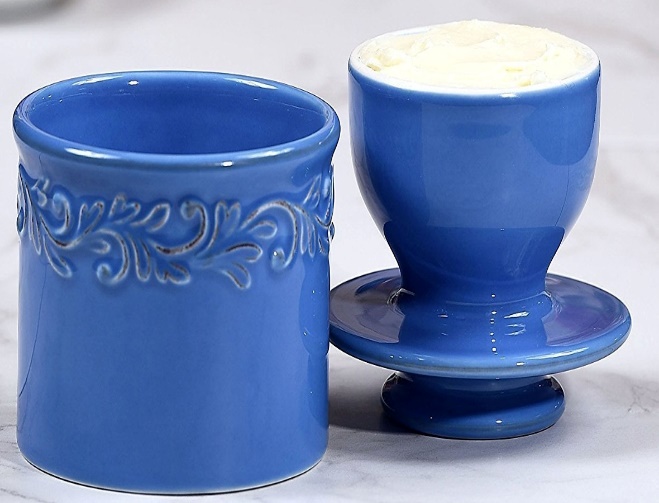
Butter Crocks keep butter fresh at room temperature (up to about 80° F) on the counter for several weeks without spoiling. At higher temperatures, the butter may slip out. This is better than a refrigerator because the butter is protected from the air, and it remains at room temperature. It won’t tear bread and is easy to measure.
The process of Churning of cream:-
Churning is the main manufacturing step to obtain butter as this is the only process to turn cream into butter. “Churned butter” is a designation indicating that butter comes from a cream that has been matured and churned traditionally. This process gives a superior quality and more flavour to the finished product.
- Churning is initiated by agitation of cream resulting numerous of air bubble incorporated in the cream. With incorporation of air bubble, the volume of cream is increased and air plasma interface.
- Churning causes partial disruption of protein membrane which is surround on each fat bubble. The fat film thus formed,serve as a foam depressant causing the air bubble to burst resulting fat globules to stick together to form larger butter grain which comes out on top of the butter milk during the process of churning of cream in making butter.
Traditional method of churning of cream or cream of milk

Pic source-pinterest
Churning of cream by mechanized method:-


Commercial production of butter-
The first commercial production of butter was made in USA in the year 1860 whereas the first successful continuous centrifugal cream separator belt driven machine was developed by a Swedish engineer Dr.Carl Gustaf Patrik de lavel. Due to the development of this machine, the manufacturing of commercial butter speeded up.
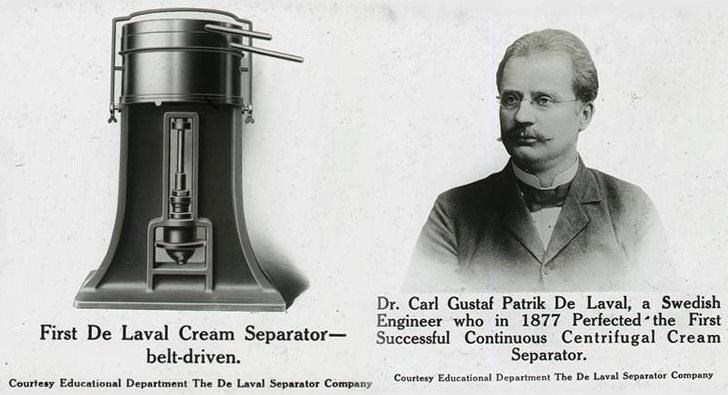
Pic source-milkday.com
Commercial production of butter in India-
Much before India became independence and Anand Milk Union Limited started the Amul revolution, Polson became India’s first commercially made butter. Launched by Parsi entrepreneur Pestonji Edulji Dalal in 1900, Polson was initially a coffee manufacturing company. It diversified into the butter business when a customer complained that there wasn’t enough butter for the armed forces. It set up its first dairy in Kaira, Gujarat.

Source-The print
- Dalal’s nickname Polly was chosen and given a British twist to name the company ‘Polson’.By the 1930s, Polson dominated the butter business in India. The downfall of the brand started when Amul entered the market.
- Dairy engineer Verghese Kurien was entrusted with the responsibility of spearheading the co-operative movement that went on to become the mammoth Amul. In the beginning, Amul found it difficult to beat Polson because Indians were used to the Polson taste. But Amul’s branding and quality was far superior and Polson was soon wiped out of the market.
History of amul butter in india:-
In 1946, local Gujarat farmer, Tribhuvandas K. Patel, encouraged farmers to create dairy cooperatives in each of their villages that would sell milk directly to Bombay instead of selling to Polson. Patel was eventually joined by Dr. Verghese Kurien and H. M. Dalaya in 1949. These three men would be responsible for giving the small dairy farmers scattered throughout India access to a centralized marketing and processing cooperation.
- The cooperation was jointly owned by all of the dairy producers. In 1955, the brand name Amul was selected because it was an acronym for the Anand Milk Union Ltd and it was similar to the Sanskrit word, amulya which means “priceless.”
- In the meantime, other districts opened up dairy cooperation’s to provide dairy to the cities throughout India. These cooperation’s realized that they could make more by joining Amul instead of competing with them; thus, they banded under the umbrella of the Gujarat Co-operative Milk Marketing Federation. The GCMMF used the brand name Amul to provide dairy products nationwide—and in just a few decades, they turned India into one of the largest producers of dairy products worldwide.

Types of Butter:-
Salted butter:
Salted butter is simply butter which contains added salt, that means salt is being added to the fresh butter to make it salted butter. Salt not only gives its saltier taste in butter but also act as a preservative and help to improve it shelf life. Salt act as a preservative agent when added in butter therefore, salted butter has a longer shelf life than unsalted butter. Longer shelf life means 3-4 months of shelf life. This does not necessarily mean that salted butter has been on the shelf longer; it simply has a longer shelf life.
- The clear difference between salted and unsalted butter is the presence of salt. Mostly unsalted butter is made with 100% cream, salted butter will have some salt added to it. The exact amount of salt present in the butter will depend on the brand.

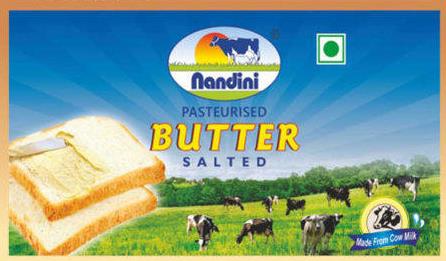
Pic source -Clover valley & Indiamart
Use of salted butter:- salted butter is used in cooking . Salted butter is perfect for spreading over crusty bread or melting over roasted corn, waffles etc. Salted butter also serves as an oil because butter is 80% fat so when butter melts it turns into oil but outmost care should be taken while cooking with butter as it has very low melting & low smoking point (Melting point of butter is 95°F/36°C & smoking point of but)ter is 300°F/150°C. Due to this properties it does not tolerate high heat as compare to any other cooking oils.
Unsalted butter (Often called Sweet butter):- Unsalted butter contains no added salt. It is 100% pure butter. As a result, unsalted butter has a shorter shelf life than salted butter. Unsalted butter has more mellow sweetness flavour than salted butter. Sweet butter spoils faster than salted butter. It’s best used in baking & can also be used in cooking where salt is desired low.
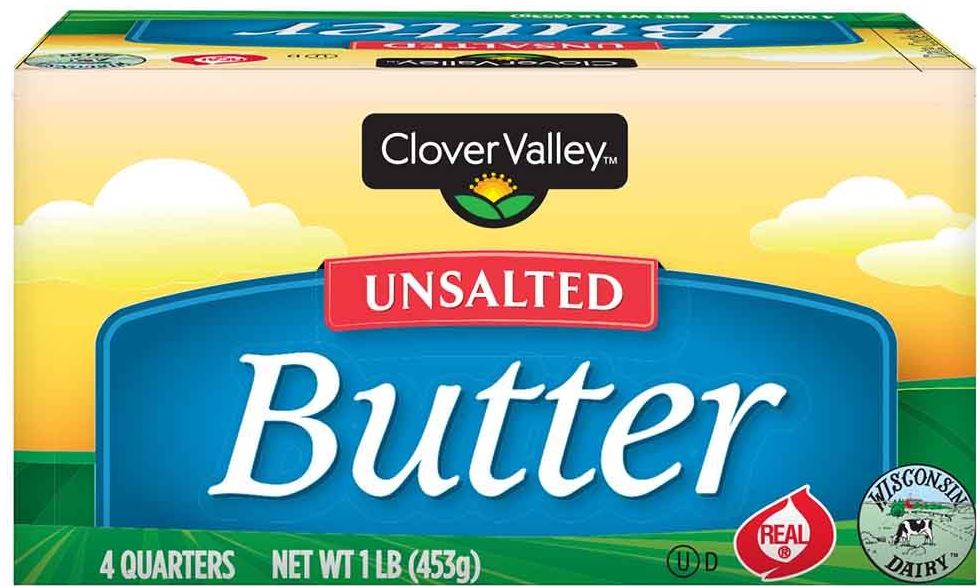

Pic source-Clover valley& land o lakes
European Butter:-This is high fat content as compare to all type of butter. Norma butter usually contains 80% of fat whereas European Butter contains higher fat i.e between 82- 85% and less moisture. It can be salted or sweet butter. Due to higher fat content in European butter, it is mainly used in bakery or baking purpose for the preparation of flakier pastries & fluffier cakes. It can also be used in the cooking but have a bit tangier flavour.
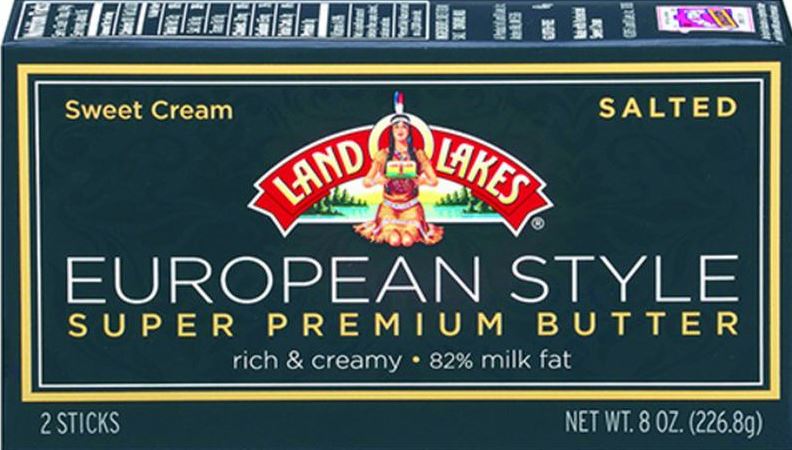
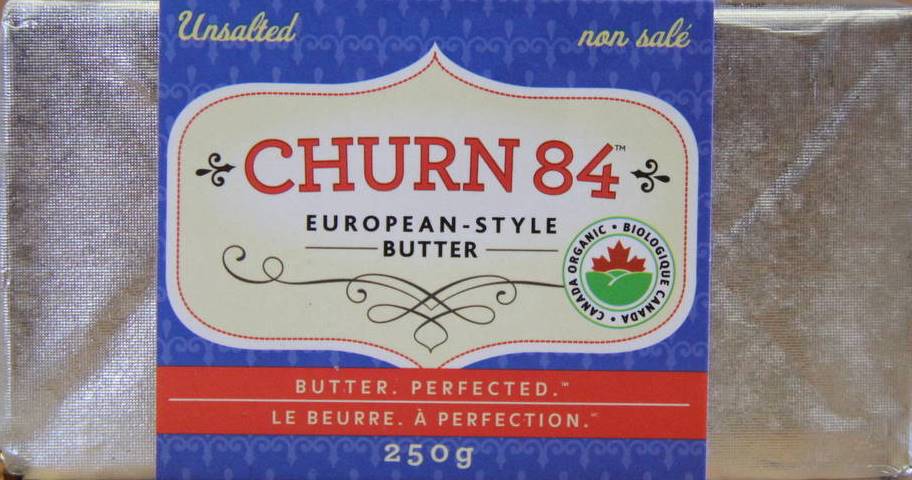
Pic source-meijer.com & ottawa organics
- Cultured Butter :–is traditionally made from pastured fresh cream and then it is fermented by incorporating live bacterial cultures and lactic acid. The fermented cream rests in a vat, where it thickens and develops wonderfully tangy flavor notes of buttermilk and hazelnuts. After fermentation, the cream is churned to make the cultured butter. It is very popular in European countries. Cultured butter can contains higher fat as same as European style of butter. Cultured butter has higher smoke point as compare to the normal butter. Due to higher smoking point it is perfect choice for sautéing food items with cultured butter.
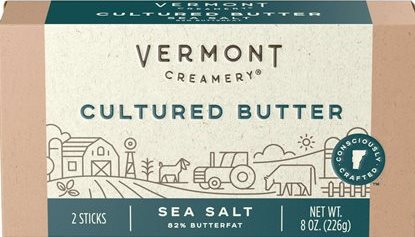

Pic source-vermontcreamery.com & Quora
Clarified Butter:- Clarified butter is pure 100% butter fat with No moisture content & No milk protein. Clarified butter is obtain after melting the unsalted butter so that all the moisture content (approx 15%) in butter gets evaporated and milk protein can be seperated or removed by filtering the clarified butter with help of strainer or cheese cloth.
Clarified butter are generally used interchangeably with Ghee. Ghee is an example of clarified butter commonly used in Indian cooking.

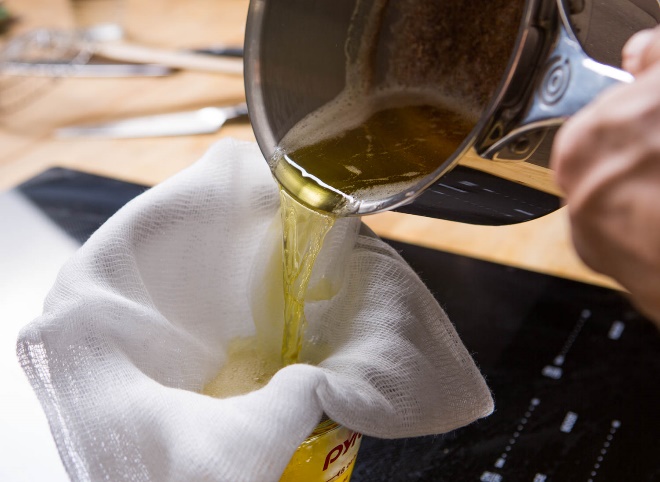
Pic source-serious eat
Is there any difference between Clarified butter & Ghee?
Yes off course, The main difference between clarified butter & Ghee is that ghee is heated until the milk solids gets brown & caramelized and sink to the bottom of the cooking pan. As a result, ghee has a nuttier taste than regular clarified butter.
- Whereas clarified butter is heated until the unsalted butter gets converted into liquid does not allow to cook for a longer time as in case of Ghee. Once melted completely, it is then strained with cheese cloths resulting it does not obtain nutty flavour as in case of ghee which is nutty flavour due to browning & caramelizing of the milk solids.
- The color of the ghee is slightly darker as compare to the clarified butter.

BROWN BUTTER:-Brown butter, also known as beurre noisette, is simply butter that has been has been heated up so that the milk solids start to brown and the water evaporates off. Compared to traditional butter, brown butter has a very different taste. The flavor is very nutty and toasted.
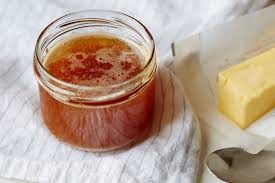
Pic source-Thekitchn.com
Culinary Use of Butter:-
Butter is a versatile ingredient in cooking and baking, valued for its flavor, texture, and culinary properties. Here’s how butter is commonly used in the kitchen:
Used in Baking:- Butter adds a rich, creamy flavor to baked goods. It enhances the taste of cookies, cakes, pastries, and muffins. In baking, butter contributes to a tender, flaky, or crumbly texture. It coats flour particles, preventing excessive gluten development, which results in a softer texture in items like cakes and cookies.
- Creaming: Butter is often creamed with sugar to create a light and fluffy texture in cakes and cookies. This process helps incorporate air into the batter, resulting in a desirable rise.
In cooking:-
- Sautéing and Frying: Butter is commonly used for sautéing vegetables and frying meats, providing flavor and a golden color. It’s especially good for cooking delicate items like eggs and fish.
- Deglazing: After searing meat, butter can be used to deglaze the pan, creating a flavorful base for sauces. The butter helps dissolve the browned bits stuck to the pan, adding depth to the sauce.
Used in preparation of Sauces and Dressings
- Sauce Base: Butter is a key ingredient in many sauces, such as beurre blanc, hollandaise, and beurre noisette. It adds richness and helps to create a smooth, velvety texture.
- Dressings: Melted butter can be used in dressings, particularly those for salads or vegetables, to add a rich flavor.
Used as a Spreads and Toppings
- Bread and Crackers: Butter is a classic spread for bread, rolls, and crackers. It adds flavor and moisture, and can be enhanced with herbs, spices, or garlic for variety.
- Vegetables: Butter is often used to dress cooked vegetables, adding flavor and richness. It can be combined with herbs or spices to create compound butters.
As a Flavoring and Seasoning
- Compound Butters: Butter can be mixed with herbs, spices, or other flavorings to create compound butters. These are used to enhance meats, vegetables, and breads, adding a burst of flavor.
- Basting: Butter is frequently used to baste meats during roasting or grilling, helping to keep them moist and flavorful.
In Pastry Making:-
- Flaky Texture: In pastry making, butter is essential for creating a flaky texture. It’s used in doughs like puff pastry, pie crusts, and croissants. The fat creates layers in the dough as it bakes, resulting in a crisp, flaky texture.
- Lamination: In laminated doughs (e.g., croissants and Danish pastries), butter is folded into the dough multiple times to create thin layers that expand and puff up during baking.
As a Flavor Infusion
- Infused Butter: Butter can be infused with various ingredients like garlic, herbs, or citrus zest to impart additional flavors. This infused butter can be used to enhance the taste of dishes or as a finishing touch.
In the preparation of Desserts
- Custards and Creams: Butter is used in custards, creams, and other rich desserts to provide a smooth texture and enhance flavor. For example, it is an ingredient in many cream sauces and custard bases.
Used in making thickening agent:- Butter is used to prepare several thickening agent such as Roux & beurre etc which is used to thicken the soup and sauces. Butter are also used to prepare the basic mother sauce and its derivative. Example of sauce which is based on melted butter are Hollandaise sauce & its derivatives of it.
Used in tempering food:- Butter is also used to tempering food, sautéing food, finishing food, topping the food, flavouring food etc.
Butter brands in India
In India, several well-known butter brands cater to different preferences and needs. Here are some popular butter brands available in India:
Amul Butter:-Amul is one of the most prominent dairy brands in India, known for its high-quality butter. Their butter is widely used for cooking, baking, and as a spread.
- Variants: Amul Butter, Amul Lactose-Free Butter.
Britannia Butter :-Britannia is a major brand in the Indian dairy market, offering butter that is popular for its taste and texture.
- Variants: Britannia Classic Butter, Britannia Cheese Spread with Butter.
Mother Dairy Butter:- Mother Dairy provides a range of dairy products, including butter that is known for its freshness and quality.
- Variants: Mother Dairy Fresh Butter.
Dairy Craft Butter:-Dairy Craft offers a variety of dairy products, including butter, which is known for its rich flavor and creamy texture.
- Variants: Dairy Craft Butter, Dairy Craft Spreadable Butter.
Vedaka Butter (Amazon Brand):–Vedaka is a private label brand available on Amazon India, offering butter that is competitive in quality and price.
- Variants: Vedaka Butter.
Sabar Dairy butter: A regional brand known in certain areas, Sabar Dairy provides butter that is appreciated for its taste and quality.
- Variants: Sabar Dairy Butter.
Danone Butter:-While primarily known for yogurt, Danone also offers butter products in the Indian market.
- Variants: Danone Butter.
What is flavored butter or compound butter:-
Compound butter is simply salted butter softened and mixed with sweet or savory ingredients such as fresh herbs & spices, fruit & vegetable, aromatic liquid etc. After mixing with herbs & spices or fruit & vegetable with salted butter, it is then piped out or rolled into cylinder shape and kept in freezer so that it get set and make easy for slice or curl. Compound butter are generally used to flavour dishes, soup, sauce, roasted meat, poultry & fish items.
Example of flavoured butter are-
- Maître ‘Hôteld butter- is an example of compound butter of French origin. It is made with butter, parsley, lemon juice, salt and pepper. It is a savory butter that is used on meats such as steak (including the chateaubriand sauce for chateaubriand steak), fish, vegetables and other foods.
- Chipolata butter:- Chipolata flavour butter is made by mixing of canned chipolata pepper & lime juice with salted butter. It is popularly used in Mexican cuisine for spreading on corn, fish, steak etc.
- Horseradish butter:- Salted butter flavoured with horseradish sauce and Dijon mustard. It is used grilled vegetable.
- Smoked paprika garlic butter:- Butter flavour with paprika powder & brown garlic.
- Herb butter:– Butter flavoured with mixture of fresh herbs.
- Red wine butter:- Butter mixed with full body red wine flavoured rosemary, garlic & chives.
- Herb gorgonzola butter:-Butter flavoured with fresh green herbs such as basil, oregano, dill with red chilly flakes.
- Truffle butter:- Butter flavoured with grated black truffle.
- Lemon, basil & garlic butter:- Butter flavour with fresh basic, garlic & a dash of lemon juice.
- Chilly lime tequila butter:-Butter flavour with green chilli, lime and hint of tequila.
- Anchovy butter;- Butter flavour with anchovies paste & herbs.
- Shallot Parsley Butter – Great on grilled steaks and warm bread.
- Lemon Chive Butter – Perfect for vegetables and chicken.
- Cilantro Lime Ginger Butter – Ideal for fish or Asian style vegetables.
- Cajun Butter – Use on grilled shrimp, white fish, and salmon.
- Orange Honey Butter – Amazing on biscuits, cornbread, zucchini bread, quick breads, and muffins
Nutritional value of Butter & Health benefit:-
Approx Nutritional value of Butter ( 100gms of butter)
- Energy :-717kcal
- Total fat- 81gms
- Saturated fat- 51 gms
- Poly Unsaturated fat- 3 gms
- Mono unsaturated fat- 21 gms
- Trans fat- 3.3 gms
- Cholesterol:-215 mg
- Sodium -11mg
- Potassium- 24mg
Health Benefit :-
Butter is a natural dairy products contains saturated fat, milk protein and some amount of water. The saturated fat found in butter are basically heart healthy. Ghee on the other hand is packed with butyrate which are proven to improve gut health. Butter also contain fat soluble vitamins. It contains vitamin A, Vitamin D & Vitamin E, Lecithin, selenium, Iodine & fatty acids. There is No carbohydrate found in butter.
- The presence of carotene in natural butter is a source of important nutrition for human beings. Carotene benefits various parts of the body. It promotes cell regrowth and repair, protecting the body from various infections.
- The consumption of butter on a regular basis in moderate amounts is beneficial to health as it provides several necessary minerals and vitamins essential for healthy living.
- Calcium and other minerals such as copper, zinc, selenium, and manganese are found in butter.
- Naturally processed butter is a heart healthy food when taken regularly in moderation. Butter fats constitute high density lipoprotein (HDL) cholesterol which is considered as good cholesterol. The omega-3 fatty acids in butter also lower the level of omega-6 fatty acids and thereby reduce the risk of heart diseases.
Content reference:-
The prime moto while preparing the above content is to educate the students who are pursuing carrier in Hospitality & food trade, Hoteliers, chefs, Hotel Management faculty members, Housewife’s etc. The above content has been compiled after referring various culinary books, Research Papers, Research articles, Food magazines, news papers, top culinary websites, Govt websites, personal interaction with renowned chefs from various hotel brands like The Ashok Group of hotel, ITC, Oberai, Leela, Park Hotels & various IHM Faculties, Nutritionists etc. & many more. The picture which i have used has been taken from the open source website .Some of the important website referred for the above content are:-
- https://www.thespruceeats.com/all-about-butter-995507
- https://www.epicurious.com/ingredients/what-is-butter
- https://www.webmd.com/diet/health-benefits-butter
- https://www.usdairy.com/news-articles/what-is-butter
- https://www.delightedcooking.com/how-is-butter-made.htm
- https://www.savorysuitcase.com/
- https://www.foodandwine.com/a-guide-to-different-styles-of-butter-8400380
- https://www.epicurious.com/ingredients/what-is-butter
- https://www.mashed.com/1101940/18-types-of-butter-and-the-best-ways-to-use-them/
- https://www.thekitchn.com/types-of-butter-23296424
- https://www.masterclass.com/articles/types-of-butter
- https://recipes.timesofindia.com/articles/features/10-types-of-butter-and-all-you-should-know-about-them/photostory/66810324.cms
- https://www.healthline.com/nutrition/foods/butter
- https://www.foodrepublic.com/1295116/different-kinds-of-butter-and-how-to-use-them/
- https://amul.com/m/about-us
